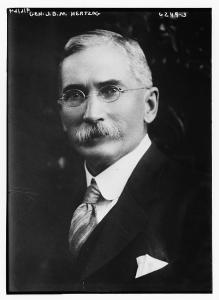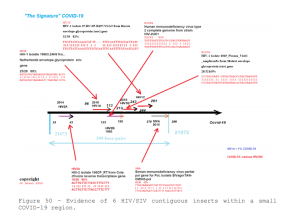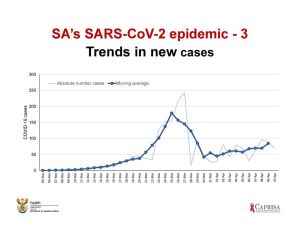A rather bizarre, jingoistic Covid-19 Freedom Day address by Julius Malema
HAVING JULIUS Malema appear on national television on Freedom Day, as if he were running the country is nothing new. But having the man appear to take charge during a National Disaster, surely one for the history books?
Today’s address must be seen as consistent with the commandeerist and vanguardist philosophy for which his far-left faction are renowned. The trouble with our national broadcaster’s approach, one of drawing in the troublesome EFF, is that it has allowed Malema to garner new opportunistic heights during the Covid-19 crisis.
Though characteristically lengthy, (I will leave it up to news media to report the nuts and bolts), the address contained more than the usual number of clangers.
Even under lockdown, he attacked the private sector which he said, could not be relied upon to provide services and said such persons were ‘driven by the profit-motive instead of coming together in times of crisis’, a fact not born out by the government’s own policy of allowing some economic activity to continue.
Witness Malema’s crass attempt to set the stage for a new ‘politics of the body’, setting the scene to take future credit for the production of ventilators and health equipment by our military-industrial complex under Denel, and a programme thus already underway.
“The South African government currently owns Denel which produces high tech fighting machines, that capacity must be directed towards the production of medical equipment. How do we explain that we can build fighter jets, fighting machines, but we cannot build a ventilator to help people breathe? Why do we have capacity to produce guns to fight wars but cannot produce machines to save lives?” he asked.
If you have not been following the details of South Africa’s national ventilator programme, or the response by local pharmaceutical companies such as Aspen, you could be forgiven for thinking that the EFF boss, had just made a major contribution on the subject, demanding local production of medicine and deployment of scarce military resources to the national effort.
Most of the politician’s address was caught up with an essentially bellicose attempt at holding both our government and industry to account for the crisis, whilst calling for stricter measures and harsher penalties, and reminding ‘revolutionaries’ that the ‘revolution was far from over, so long as the land was in white hands.’
‘If any workers lives were lost as a result of a premature exit from the national lockdown’, he fulminated, there would be hell to pay. In particular his party would make sure that for each worker’s life lost, the family ‘would receive at least R5 million’.
This after demanding an increase of the emergency crisis grant, to R1000. No credit given for President Ramaphosa’s historic introduction of a basic income grant (BIG) in times of need. Which is a bit like saying, ‘up the grant, and we will negotiate a payout if you die, or else’.
Not even socialist Sweden, which did not embrace a lockdown, has the kind of money to pay its entire population R1000pm, indefinitely, without there being some form of concomitant work in return, and thus a contribution by all workers to the nation’s exchequer. Malema however, called for BIG to be made permanent, and also demanded laptops and tablets for learners, another policy already implemented to some extant by the ANC, alongside E-learning.
Not content with playing catch-up to the ruling party and its remarkable series of interventions announced over the past week, by demanding stricter measures, and a return to moribund SOEs, Malema then proceeded to draw the kind of racist distinctions for which he is also famous.
One distinction in particular jarred, that made between European and Non-European, or in Malema terms, African and Non-African. That Malema was merely paraphrasing racist invective from the past whilst appearing to couch his arguments within the terms of black pride, can be seen in the following bizarre statement:
“Everyone thinks they are better than an African, they can made (sic) the worst form of suffering like Holocaust and bullets, they still will see themselves as better than Africans, meaning instead of human tragedy making them identify with Africans, they will still think of their own human suffering as better than being an African, why because African is being trapped in a skin colour, a body one can never escape.”
It was Adolf Hitler who made a distinction between what he termed Aryan, and Non-Aryan. It took apartheid founders such as DF Malan and HF Verwoerd to extend this classification system into the binary, European and Non-European, and thus some wind to the kind of racist terms deployed by Malema today.
But I fear, it takes a special type of jingoism, an inversion of logic if you will, for the result to blur into a scenario where ‘Hitler’s suffering’ is at the heart of all the problems to do with the black body. And where contrary to black consciousness leader, Steve Biko, ‘blackness is now purely the result of skin pigmentation’. All whilst calling essentially for a school curriculum that could see compulsory political re-education camps and censure on the basis of ideological outlook?
The sheer problem of metaphysical and epic proportions, in the extrapolation of a new ‘physicality of the body politic’ as a Covid19 ‘discourse of suffering’ by Malema, requires a lot more rumination than is possible on Freedom Day.
However, one of the tactics deployed by the self-styled and would-be Marxist dictator over the years, has been to cast himself as an unstoppable theoretical force, already in power. (By the powers of Fanon & Sankara?). If only the outcome of the ballot paper were a bit different and our nation’s ideological battles could be resolved with a simple tick of the pen?
Freedom day is surely not the time to be making distinctions on the basis of race, colour, religion and creed? And a crisis is not the place to be issuing forth on a treatment regime for some at the expense of others? But of course, we all get that Malema is about to volunteer for the treatment action campaign, or do we?
No other opposition leader has been given quite the same legroom by our nation’s institutions to attack democracy (or the marketplace) from within, whether in terms of editorial or column space, and thus to gain access to radio listeners and television spectators thereby, using the very mechanisms of power.
Malema’s party has too readily been granted the kind of privilege reserved for our democratic founders, and the type of audience reserved for visiting heads of state, in issuing forth racist cant that divides our nation, not between the haves and have-nots, but between those who qualify as Africans in Malema’s eyes, and those who do not.
For many commentators, the emergence of the EFF is a strange fact of South African life, orchestrated by party insiders, those wanting to create an antidote to the mostly white official opposition, and those who want merely to steal the revolution.
It is time to call-out what is occurring before our eyes, on the nation’s screens, in the negation of the democratic promise of universal rights and freedom for all citizens, black and white.




